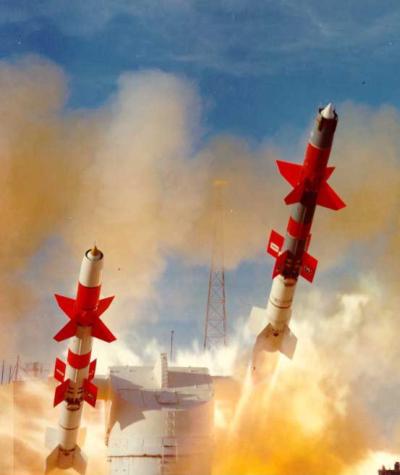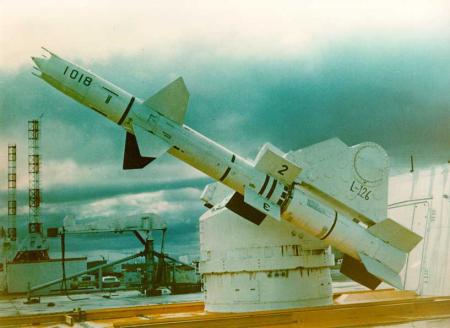Bendix RIM-8 Talos (original) (raw)
Bendix SAM-N-6/IM-70/RIM-8 Talos
The Talos long-range surface-to-air missile was the ultimate result of the U.S. Navy's Bumblebee program, which also led to the SAM-N-7/RIM-2 Terrier and RIM-24 Tartar missiles.
Bumblebee was begun in 1944 with the goal to create a ramjet-powered anti-aircraft missile. The initial development was done by the Applied Physics Lab of the John Hopkins University, and APL started to fly the Cobra ramjet test vehicles in 1945, which eventually led to the larger PTV-N-4 BTV (Burner Test Vehicle) in 1948. The Talos was to have a primary beam-riding guidance system, and in 1948, supersonic beam-riding was demonstrated with theCTV-N-8 STV (Supersonic Test Vehicle). These tests proved very promising, and STV was actually developed into a tactical missile of its own, theSAM-N-7/RIM-2 Terrier medium-range SAM. The final Talos test vehicle was theRTV-N-6 XPM (Experimental Prototype Missile), which first flew successfully in 1951 as the RTV-N-6a3. By that time, the Talos SAM had been assigned the designation SAM-N-6 by the Navy. The first full Talos prototype (XSAM-N-6) flew in October 1952, and later that year, the first successful intercept was made by an RTV-N-6a4 test vehicle. Because the required missile performance was increased several times during development, the Talos SAM did not become fully operational until 1959, almost a decade later than originally planned. Bendix became prime contractor for Talos production.
The first operational Talos was designated SAM-N-6b. I haven't found any evidence of a SAM-N-6adesignation, but this was probably assigned to some interim configuration during the lengthy development phase. The SAM-N-6b used a solid-fueled rocket booster and a Bendix ramjet for sustained flight. Talos was guided to its target by beam-riding, and used semi-active pulse-radar guidance for terminal homing. The characteristical small antennas around the nose of the Talos missile were the receivers for the SARH system. Talos missiles without these antennas were either training rounds, or nuclear armed missiles, which didn't use terminal homing. SAM-N-6b missiles had conventional HE warheads. The beam-riding guidance enabled the Talos to attack enemy aircraft from above, which could be an unpleasant surprise to pilots who had been trained to expect SAMs from below.
The SAM-N-6bW was identical to the SAM-N-6b, except for the W-30 nuclear warhead (2 - 5 kT yield). Terminal homing was regarded as unnecessary for a nuclear-armed missile, and so the the SAM-N-6bW airframe lacked the small SARH antennas.
 |
|---|
| Photo: U.S. Navy |
| Left: SAM-N-6bW (RIM-8B); Right: SAM-N-6b (RIM-8A) |
The SAM-N-6b1 became operational in 1960. It had almost double the effective range of the SAM-N-6b, and had a new continuous-rod warhead with higher lethality. SAM-N-6bW1 was the nuclear armed equivalent of the 6bW.
The separate conventional and nuclear armed missiles were a bit impractical, because every Talos ship had to store at least some nuclear missiles, although these would most probably never be needed. Therefore a new version, the SAM-N-6c1"Unified Talos", was introduced in 1962. With this model, the conventional and nuclear warhead could be exchanged on-board. The SAM-N-6c1 also had a higher ceiling and a new continuous-wave (CW) radar seeker for terminal homing, which improved effectiveness against low-flying targets. The Unified _Talos_soon replaced most earlier missiles on the Navy's ships. A few SAM-N-6b1 missiles were also fitted with the CW seeker, and redesignatedSAM-N-6b1(CW).
First a brief period in the mid-50's, the U.S. Air Force considered using a land-based Talos missile (called_Talos-L_ or Talos-W) as an interim interceptor missile, until the IM-99/CIM-10 Bomarcwould be ready. In 1955, the IM-70 designator was assigned by the USAF, and the designations XIM-70A and XIM-70Cwere reserved by the for land-based equivalents of the Navy's then projected SAM-N-6b1 and SAM-N-6bW1 variants, respectively (there are no records of a -70B designation). However, interest remained low, and in 1957 the land-based Talos project was transferred to the Army and cancelled soon after.
All Talos variants had some surface-to-surface capability, although probably only the nuclear-tipped versions would have been really effective. In 1963, all variants of Talos were redesignated in the RIM-8 series, as follows:
| Old Designation | New Designation |
|---|---|
| SAM-N-6b | RIM-8A |
| SAM-N-6bW | RIM-8B |
| SAM-N-6b1 | RIM-8C |
| SAM-N-6bW1 | RIM-8D |
| SAM-N-6c1 | RIM-8E |
| SAM-N-6b1(CW) | RIM-8F |
The RIM-8G had an improved beam-riding guidance and became operational in 1966. The final surface-to-air _Talos_version was RIM-8J, which had improved SARH guidance and entered service in 1968. In 1968, a Talos fired from the USS Long Beach shot down a Vietnamese MiG at very long range. In total, three MiG kills in South-East Asia were credited to Talos missiles.
 |
|---|
| Photo: U.S. Navy |
| RIM-8G |
RGM-8H Talos-ARM was a dedicated anti-radiation missile for use against shore-based radar stations.Talos-ARM could be fitted with seekers for various radar frequencies, and also employed some ECCM features. Flight tests were performed in 1965 and soon after, the RGM-8H was operational in South-East Asia, where it was used in combat against Vietnamese SAM radars.
Phase-out of the Talos began in 1974, and in 1979 the last operational Talos ship was retired. The originally planned replacement, the SAM-N-8/RIM-50 Typhon LR had been cancelled, but long-range air-defence was eventually provided by the RIM-67 Standard ERmissile. The remaining Talos missiles were converted to MQM-8G Vandal supersonic targets, simulating anti-ship missile threats.
Later modifications of the basic MQM-8G Vandal resulted in the non-standard designations MQM-8X (called_Fleet Vandal_), MQM-8G/ER (Extended Range) and MQM-8G/EER (Extended Extended Range). The ER and EER versions were in use until July 2005, when the last of 644 Vandal targets was flown. The MQM-8G was replaced by theGQM-163 Coyote SSST (Supersonic Sea-Skimming Target).
Specifications
Note: Data given by several sources show slight variations. Figures given below may therefore be inaccurate!
Data for RIM-8G, except where noted:
| Length (w/o booster) | 6.40 m (21 ft); booster: 3.35 m (11 ft) |
|---|---|
| Wingspan | 2.80 m (110 in) |
| Finspan | 2.05 m (81 in) |
| Diameter | 0.71 m (28 in); booster: 0.76 m (30 in) |
| Weight (w/o booster) | 1540 kg (3400 lb); booster: 1990 kg (4400 lb) |
| Speed | Mach 2.5 |
| Ceiling | 24400 m (80000 ft) |
| Range | 185 km (100 nm); RIM-8A: 92 km (50 nm) |
| Propulsion | MK 11 solid-fueled rocket boosterBendix ramjet sustainer |
| Warhead | 136 kg (300 lb) continuous-rod HE warhead or W-30 nuclear warhead (2 - 5 kT) |
Main Sources
[1] Norman Friedman: "US Naval Weapons", Conway Maritime Press, 1983
[2] Bill Gunston: "The Illustrated Encyclopedia of Rockets and Missiles", Salamander Books Ltd, 1979
[3] James N. Gibson: "Nuclear Weapons of the United States", Schiffer Publishing Ltd, 1996
Back to Current Designations Of U.S. Unmanned Military Aerospace Vehicles
Back to Directory of U.S. Military Rockets and Missiles
Last Updated: 29 September 2009